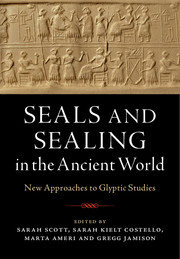 Seals and Sealing in the Ancient World
Seals and Sealing in the Ancient World Book contents
- Seals and Sealing in the Ancient World
- Seals and Sealing in the Ancient World
- Copyright page
- Contents
- Notes on Contributors
- Illustrations
- Plates
- Tables
- Acknowledgments
- Preface
- Abbreviations
- Chapter One Introduction: Small Windows, Wide Views
- Part I The Ancient Near East and Cyprus
- Part II South Asia and the Gulf Region
- Chapter Eight Indus Seals and Glyptic Studies: An Overview
- Chapter Nine Letting the Pictures Speak: An Image-Based Approach to the Mythological and Narrative Imagery of the Harappan World
- Chapter Ten Understanding Indus Seal-Carving Traditions: A Stylistic and Metric Approach
- Chapter Eleven Operational Sequences and Stamp Seals: A Preliminary Report on an Experimental and Microtopographic Framework for Identifying Groups of Seal Carvers in the Indus Civilization
- Chapter Twelve Seals and Sealing Technology in the Dilmun Culture: The Post-Harappan Life of the Indus Valley Sealing Tradition
- Part III Egypt
- Part IV Aegean
- References
- Endnotes
- Index
Chapter Eleven - Operational Sequences and Stamp Seals: A Preliminary Report on an Experimental and Microtopographic Framework for Identifying Groups of Seal Carvers in the Indus Civilization
from Part II - South Asia and the Gulf Region
Published online by Cambridge University Press: 24 April 2018
- Seals and Sealing in the Ancient World
- Seals and Sealing in the Ancient World
- Copyright page
- Contents
- Notes on Contributors
- Illustrations
- Plates
- Tables
- Acknowledgments
- Preface
- Abbreviations
- Chapter One Introduction: Small Windows, Wide Views
- Part I The Ancient Near East and Cyprus
- Part II South Asia and the Gulf Region
- Chapter Eight Indus Seals and Glyptic Studies: An Overview
- Chapter Nine Letting the Pictures Speak: An Image-Based Approach to the Mythological and Narrative Imagery of the Harappan World
- Chapter Ten Understanding Indus Seal-Carving Traditions: A Stylistic and Metric Approach
- Chapter Eleven Operational Sequences and Stamp Seals: A Preliminary Report on an Experimental and Microtopographic Framework for Identifying Groups of Seal Carvers in the Indus Civilization
- Chapter Twelve Seals and Sealing Technology in the Dilmun Culture: The Post-Harappan Life of the Indus Valley Sealing Tradition
- Part III Egypt
- Part IV Aegean
- References
- Endnotes
- Index
Summary
Stamp seals comprised a critical component of the administrative infrastructure of the Indus Civilization. Each stamp seal is the result of a unique sequence of actions that was shaped by a particular configuration of social relations. Reconstructing operational sequences, specific intervals of action utilized in seal production, can provide insight into shifting social boundaries among seal carvers in the Indus Civilization. In this chapter I present a preliminary report on a new approach that draws upon experimental replication and microtopographic analysis to infer the operational sequences used to produce particular seals. Toward this end, a team of volunteers engaged in an archaeological replication project that generated a sample of thirty experimental seals using tools and techniques derived from the archaeological record. Using microscopic techniques that facilitated the identification of the experimental seals’ operational sequences, I reconstructed the operational sequences employed by Indus carvers to create two stamp seals from the archaeological site of Chanhu-daro. I find significant differences in the seals’ operational sequences, supporting the conclusion that the tested artifacts were not carved by the same or closely related people. These results expand upon work that emphasizes the analysis of stylistic attributes. In the future I will draw on this approach to delineate the operational sequences used to produce a large sample of seals, enhancing our understanding of the role of seal carvers in the political economy of the Indus Civilization.
- Type
- Chapter
- Information
- Seals and Sealing in the Ancient WorldCase Studies from the Near East, Egypt, the Aegean, and South Asia, pp. 187 - 203Publisher: Cambridge University PressPrint publication year: 2018


